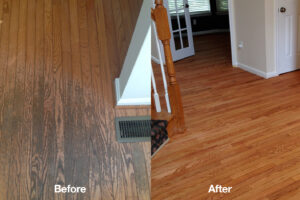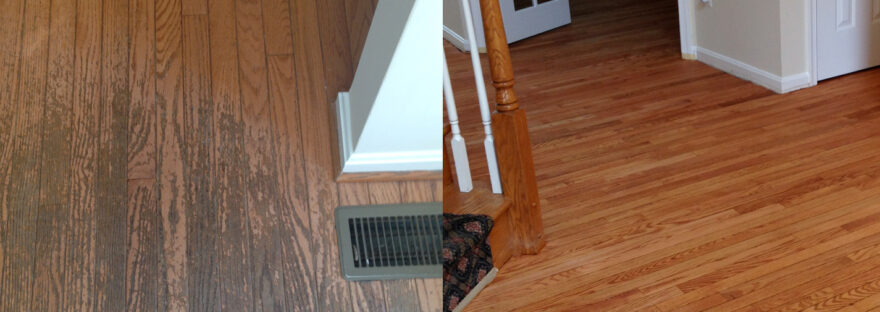Hardwood Floor Refinishing Bergen County NJ is a lengthy, labor-intensive project. It involves sanding down the boards, staining them, and then sealing them.
A new coating of polyurethane adds a fresh look to hardwood floors and protects them against damage, but the process produces a lot of dust. Large fans help keep the air clean while working.
If you have hardwood floors, refinishing them can give your home an updated look. Refinishing is a process of removing the old finish, sanding and then applying stain and a top coat. It takes between two and four days depending on the size of the room and the type of finish used. During the sanding process, it is important to be careful not to sand too much, which can cause the wood to become splintered. This can also be caused by using a drum sander, which can over-saturate the grain of the wood, leaving it rough and uneven.
While you are sanding the floor, it is a good idea to open windows to improve ventilation and wear a dust mask or HEPA-level N95 respirator. This will help you avoid sinus problems and other respiratory issues. It’s also a good idea to remove items from the room, such as furniture, rugs and wall decorations. You should also tape off or cover things like thermostats and wall units that will be exposed to the sanding dust. You’ll also want to cover any electrical outlets with plastic to keep the dust from settling on them.
Staining can be done to enhance the natural color of the wood or to change its color completely. It is recommended that you use a low-VOC stain, as these are less harmful to the environment and to your health. It is also important to note that different woods react to stains in different ways, so you may need to apply the stain more than once to get the desired result.
Once the stain has been applied, it can take one to two days for it to dry. Then, the floors can be sealed with a polyurethane sealant to protect them. Polyurethane is a clear, almost plastic-like substance that can be found in a variety of sheens, from matte to glossy. It is the most common topcoat for hardwood floors.
It’s best to wait a week or more before walking on the newly-finished floors, so that the polyurethane can fully cure. You should also be cautious about dragging heavy furniture across the floors, as it can leave marks and dents that can take time to remove.
Staining
Staining is the process of applying a color to your hardwood floors. This can be done with either an oil-based or water-based stain. Generally, an oil-based stain will produce more of a sheen than a water-based one. There are also some additives that can be used with an oil-based stain to help reduce the amount of VOCs (volatile organic compounds) emitted.
When deciding on a color, you should take into consideration the look you want for your home as well as the type of wood your floors are made from. Different types of wood have different grain patterns, which can create different effects when stained. For example, if your hardwood floors have a swirly pattern, it is likely they are mahogany, while a curly grain is most often found in maple and oak.
Once you have chosen the color, your floor specialist can mix it to match your existing stains or provide a new color that will give your floors a fresh look. It is important that the floor be sanded and cleaned prior to staining, to minimize the amount of dust that will be introduced into the finished product.
After the stain has been applied and allowed to dry, a final step is to apply a polyurethane finish to the floor. This will protect the new stain and add a sheen to the flooring. This step will usually take 4-6 days to complete. During this time, your family and pets should stay away from the home due to the odors and vapors emitted during the polyurethane process.
When applying the polyurethane, a high-density foam roller and/or two-inch paintbrush can be used to cover the entire surface of the floor. Then, the polyurethane is rubbed with a cloth to smooth it out and remove any blemishes or bubbles.
After the polyurethane has dried, it is recommended that you replace rugs and furniture gently. The floors may need to fully cure for 15-30 days before they can be walked on, but this is up to the homeowner’s discretion. Until the finish is completely cured, it is best not to put any heavy furniture on the floor.
Sealing
There comes a time in the life of all hardwood floors when they need a little TLC. When this happens, a flooring professional will recommend refinishing them. Refinishing is a process of sanding the surface of your hardwood floors, then applying a new coat of protectant finish. This protects the wood from impact damage, humidity and general wear and tear.
Refinishing is a very involved task and it takes a flooring professional to get the results you expect. To start with, the sanding needs to be done correctly, as even a small amount of unevenness can create problems when you apply your new finish. After sanding, you need to wait for the floor to dry completely. Depending on the type of finish you have chosen, it may take up to 24 hours for each coat of finish to dry. The final step in the refinishing process is sealing.
Choosing the right sealer is important. There are water based and oil based polyurethanes available, each with its own benefits. For example, a water based poly will leave the hardwood floors looking as though they have no finish at all, while an oil based poly will provide a rich amber look.
Sealing will also help to protect the wood from moisture damage. The Raleigh and Apex areas experience a wide range of weather conditions, from hot and humid summers to cold and damp winters. Moisture can cause the wood to swell or buckle, which damages the structural integrity of your floors. A good quality oil based gymnasium grade polyurethane will prevent this damage by creating a protective barrier between the wood and the elements.
One of the biggest mistakes homeowners make when refinishing their own floors is that they don’t sand and finish them correctly. This can cause the new finish to crack or chip. In addition, a poorly sanded floor will be more susceptible to water damage and other harmful environmental factors.
Another mistake that homeowners often make is using the wrong type of stain on their hardwood floors. Different types of hardwood require a specific stain, and it is essential to use the correct type. For example, bamboo is a durable hardwood that responds well to sanding and staining, but it won’t stain as darkly as oak or cherry.
Cleaning
When you have hardwood floors, you will need to clean them regularly to keep them looking good. Daily traffic brings in dirt, pebbles, dust and other small debris that can cause scratches and nicks on wood surfaces. Using a soft cloth sweeper or vacuum with a hard floor attachment as often as the amount of traffic in your home requires will help remove this debris and prevent it from damaging your hardwood floors.
Vacuuming and sweeping will also remove any dirt that is lodged in between floorboards. Then you will want to damp mop the floors with a cleaner that is formulated for hardwood floors. A product such as Method Squirt and Mop or Bona Hardwood Floor Cleaner will work well. Avoid using products that produce foam or suds on wood floors as they can leave residue and damage the finish.
Stains on wood floors can be a challenge and should only be tackled by a qualified flooring professional. If your wood has deep stains that have eaten through the top layer of your hardwood floor, re-staining and refinishing is likely required.
Refinishing is a complex process that involves sanding down the existing floor and then putting down a new coat of finish. It is a very detailed job that requires experience with the right equipment and knowledge of how to use it properly.
To minimize the chance of this happening to your home, a professional should be hired for any sanding or refinishing project that is planned. This will ensure that the job is done correctly and that all necessary precautions are taken to protect the furniture, draperies and other surfaces that cannot be moved during this process.
Staining and sealing can be a DIY project, but if you have any doubts about the ability of your home to complete these tasks safely or with the desired results, hire a professional. These processes are not for the novice DIYer and can require days or weeks of downtime. A skilled and experienced flooring contractor can have these projects completed quickly and efficiently, minimizing any disruption to your daily life.

